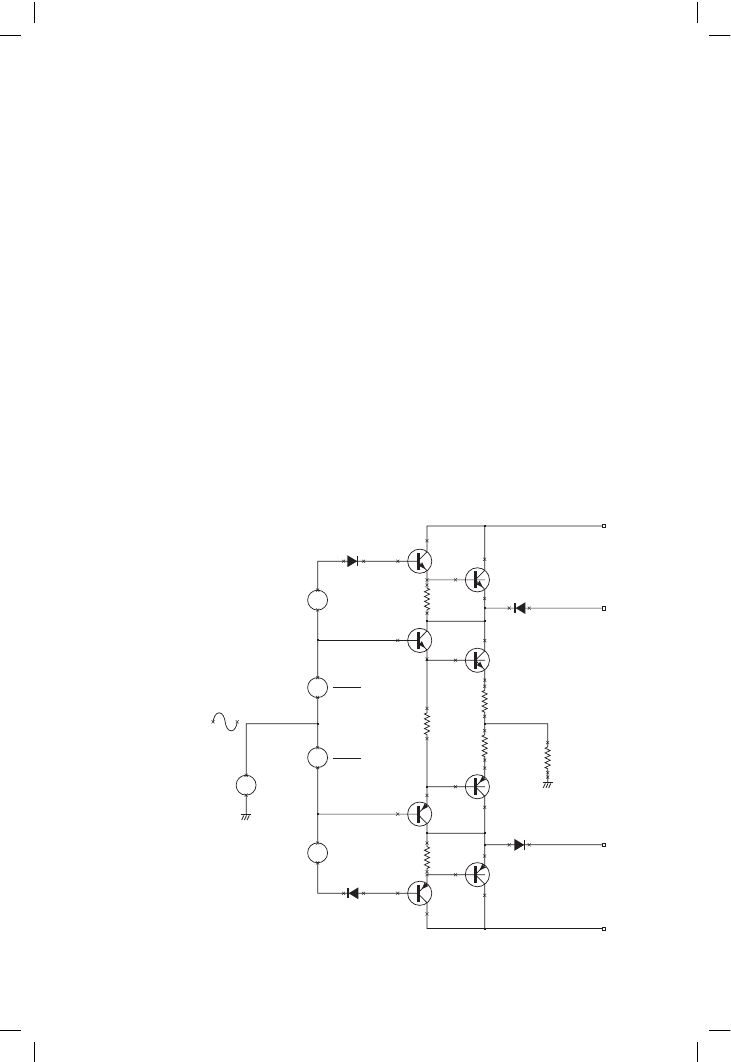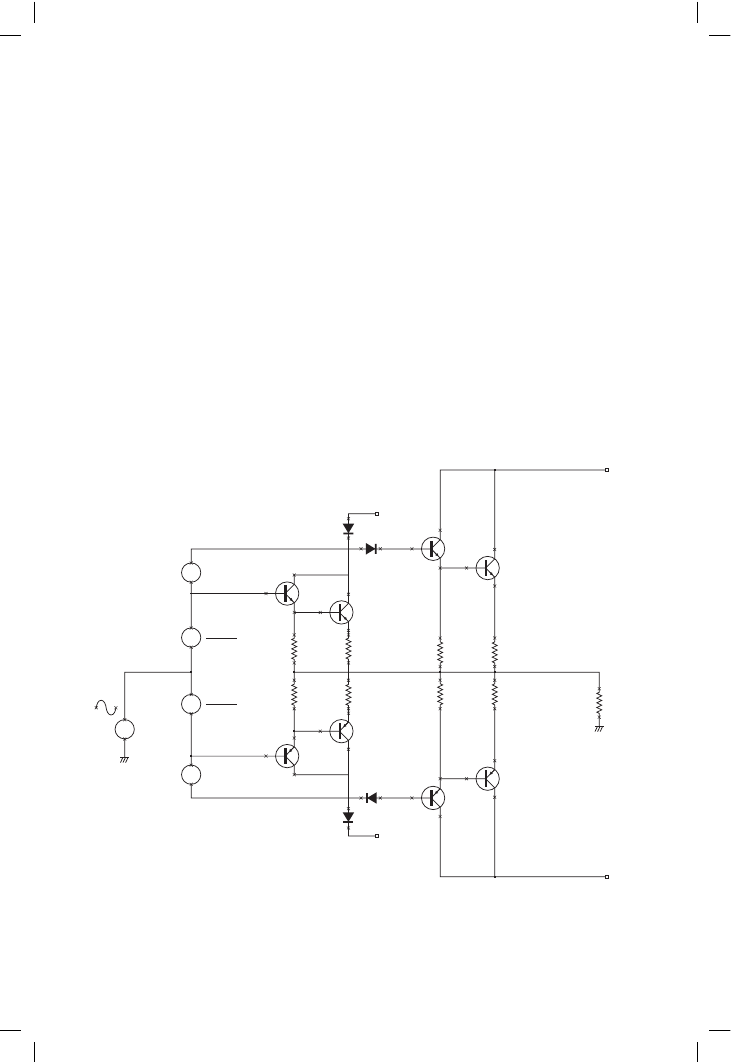ВУЗ: Казахская Национальная Академия Искусств им. Т. Жургенова
Категория: Учебное пособие
Дисциплина: Не указана
Добавлен: 03.02.2019
Просмотров: 17358
Скачиваний: 18

History, architecture and negative feedback
Class AB is less linear than either A or B, and in my view its only legitimate
use is as a fallback mode to allow Class-A amplifiers to continue working
reasonably when faced with a low load impedance.
Class-B
Class-B is by far the most popular mode of operation, and probably more
than 99% of the amplifiers currently made are of this type. Most of this
book is devoted to it, so no more is said here.
Class-C
Class-C implies device conduction for significantly less than 50% of the
time, and is normally only usable in radio work, where an LC circuit can
smooth out the current pulses and filters harmonics. Current-dumping
amplifiers can be regarded as combining Class-A (the correcting amplifier)
with Class-C (the current-dumping devices); however it is hard to visualise
how an audio amplifier using devices in Class-C only could be built.
Class-D
These amplifiers continuously switch the output from one rail to the other
at a supersonic frequency, controlling the mark/space ratio to give an
average representing the instantaneous level of the audio signal; this is
alternatively called Pulse Width Modulation (PWM). Great effort and
ingenuity has been devoted to this approach, for the efficiency is in theory
very high, but the practical difficulties are severe, especially so in a world
of tightening EMC legislation, where it is not at all clear that a 200 kHz
high-power square wave is a good place to start. Distortion is not inherently
low
[5]
, and the amount of global negative feedback that can be applied is
severely limited by the pole due to the effective sampling frequency in the
forward path. A sharp cut-off low-pass filter is needed between amplifier
and speaker, to remove most of the RF; this will require at least four
inductors (for stereo) and will cost money, but its worst feature is that it will
only give a flat frequency response into one specific load impedance. The
technique deserves a book to itself, and cannot be dealt with properly here.
Other references to consult for further information are Goldberg and
Sandler
[6]
and Hancock
[7]
.
Class-E
An extremely ingenious way of operating a transistor so that it has either a
small voltage across it or a small current through it almost all the time; in
other words the power dissipation is kept very low
[8]
. Regrettably this is an
RF technique that seems to have no sane application to audio.
Class-F
There is no Class-F, as far as I know. This seems like a gap that needs
filling . . .
35

Vbias3
Inner driver
R2
100R
Outer
power
device
TR6
Inner
power
device
TR1
TR3
TR4
TR8
TR2
TR7
R1
200R
R3
100R
V in
Vbias4
Vbias
2
Vbias
2
D3
D4
Re
0R1
Re
0R1
Rload
8R
D1
D2
V2+
+50V
V1+
+15V
-15V
V1-
-50V
V2-
Audio Power Amplifier Design Handbook
Class-G
This concept was introduced by Hitachi in 1976 with the aim of reducing
amplifier power dissipation. Musical signals have a high peak/mean ratio,
spending most of the time at low levels, so internal dissipation is much
reduced by running from low-voltage rails for small outputs, switching to
higher rails current for larger excursions.
The basic series Class-G with two rail voltages (i.e. four supply rails, as both
voltages are +/–) is shown in Figure 2.3
[9],[11]
. Current is drawn from the
lower +/–V1 supply rails whenever possible; should the signal exceed
+/–V1, TR6 conducts and D3 turns off, so the output current is now drawn
entirely from the higher +/–V2 rails, with power dissipation shared between
TR3 and TR6. The inner stage TR3, 4 is usually operated in Class-B,
although AB or A are equally feasible if the output stage bias is suitably
increased. The outer devices are effectively in Class-C as they conduct for
significantly less than 50% of the time.
In principle movements of the collector voltage on the inner device
collectors should not significantly affect the output voltage, but in practice
Class-G is often considered to have poorer linearity than Class-B because of
glitching due to charge storage in commutation diodes D3, D4. However, if
36
Figure 2.3
Class-G-Series output
stage. When the
output voltage exceeds
the transition level, D3
or D4 turn off and
power is drawn from
the higher rails through
the outer power
devices

Vbias3
Vbias4
Vin
Vbias
2
Vbias
2
R2
100R
Q1
Q3
Q5
Q7
Q8
Q6
Q4
D3
D4
D2
D1
Low
voltage
power
device
High
voltage
driver
Low voltage
driver
High
voltage
power
device
R4
100R
R5
100R
Re
0R1
Re
0R1
Re
0R1
Re
0R1
Q2
R3
100R
Rload
8R
-50V
V2-
V2+
+50V
History, architecture and negative feedback
glitches occur they do so at moderate power, well displaced from the
crossover region, and so appear relatively infrequently with real signals.
An obvious extension of the Class-G principle is to increase the number of
supply voltages. Typically the limit is three. Power dissipation is further
reduced and efficiency increased as the average voltage from which the
output current is drawn is kept closer to the minimum. The inner devices
operate in Class-B/AB as before, and the middle devices are in Class-C. The
outer devices are also in Class-C, but conduct for even less of the time.
To the best of my knowledge three-level Class-G amplifiers have only been
made in Shunt mode, as described below, probably because in Series mode
the cumulative voltage drops become too great and compromise the
efficiency gains. The extra complexity is significant, as there are now six
supply rails and at least six power devices all of which must carry the full
output current. It seems most unlikely that this further reduction in power
consumption could ever be worthwhile for domestic hi-fi.
A closely related type of amplifier is Class-G-Shunt
[10]
. Figure 2.4 shows
the principle; at low outputs only Q3, Q4 conduct, delivering power from
37
Figure 2.4
A Class-G-Shunt output stage, composed of two EF output stages with the usual drivers. Vbias3, 4 set the
output level at which power is drawn from the higher rails

Audio Power Amplifier Design Handbook
the low-voltage rails. Above a threshold set by Vbias3 and Vbias4, D1 or
D2 conduct and Q6, Q8 turn on, drawing current from the high-voltage
rails, with D3, 4 protecting Q3, 4 against reverse bias. The conduction
periods of the Q6, Q8 Class-C devices are variable, but inherently less than
50%. Normally the low-voltage section runs in Class-B to minimise
dissipation. Such shunt Class-G arrangements are often called ‘commu-
tating amplifiers’.
Some of the more powerful Class-G-Shunt PA amplifiers have three sets of
supply rails to further reduce the average voltage drop between rail and
output. This is very useful in large PA amplifiers.
Class-H
Class-H is once more basically Class-B, but with a method of dynamically
boosting the single supply rail (as opposed to switching to another one) in
order to increase efficiency
[12]
. The usual mechanism is a form of
bootstrapping. Class-H is occasionally used to describe Class-G as above;
this sort of confusion we can do without.
Class-S
Class-S, so named by Doctor Sandman
[13]
, uses a Class-A stage with very
limited current capability, backed up by a Class-B stage connected so as to
make the load appear as a higher resistance that is within the first
amplifier’s capability.
The method used by the Technics SE-A100 amplifier is extremely
similar
[14]
.
I hope that this necessarily brief catalogue is comprehensive; if anyone
knows of other bona fide classes I would be glad to add them to the
collection. This classification does not allow a completely consistent
nomenclature; for example, Quad-style Current-Dumping can only be
specified as a mixture of Class A and C, which says nothing about the basic
principle of operation, which is error-correction.
Variations on Class-B
The solid-state Class-B three-stage amplifier has proved both successful and
flexible, so many attempts have been made to improve it further, usually by
trying to combine the efficiency of Class-B with the linearity of Class-A. It
would be impossible to give a comprehensive list of the changes and
improvements attempted, so I give only those that have been either
commercially successful or particularly thought-provoking to the amplifier-
design community:
38

History, architecture and negative feedback
Error-correcting amplifiers
This refers to error-cancellation strategies rather than the conventional use
of negative feedback. This is a complex field, for there are at least three
different forms of error-correction, of which the best known is error-
feedforward as exemplified by the ground-breaking Quad 405
[15]
. Other
versions include error feedback and other even more confusingly-named
techniques, some at least of which turn out on analysis to be conventional
NFB in disguise. For a highly ingenious treatment of the feedforward
method by Giovanni Stochino
[16]
.
Non-switching amplifiers
Most of the distortion in Class-B is crossover distortion, and results from
gain changes in the output stage as the power devices turn on and off.
Several researchers have attempted to avoid this by ensuring that each
device is clamped to pass a certain minimum current at all times
[17]
. This
approach has certainly been exploited commercially, but few technical
details have been published. It is not intuitively obvious (to me, anyway)
that stopping the diminishing device current in its tracks will give less
crossover distortion. See also Chapter 9.
Current-drive amplifiers
Almost all power amplifiers aspire to be voltage sources of zero output
impedance. This minimises frequency response variations caused by the
peaks and dips of the impedance curve, and gives a universal amplifier that
can drive any loudspeaker directly.
The opposite approach is an amplifier with a sufficiently high output
impedance to act as a constant-current source. This eliminates some
problems – such as rising voice-coil resistance with heat dissipation – but
introduces others such as control of the cone resonance. Current amplifiers
therefore appear to be only of use with active crossovers and velocity
feedback from the cone
[18]
.
It is relatively simple to design an amplifier with any desired output
impedance (even a negative one) and so any compromise between voltage
and current drive is attainable. The snag is that loudspeakers are universally
designed to be driven by voltage sources, and higher amplifier impedances
demand tailoring to specific speaker types
[19]
.
The Blomley principle
The goal of preventing output transistors from turning off completely was
introduced by Peter Blomley in 1971
[20]
; here the positive/negative
splitting is done by circuitry ahead of the output stage, which can then be
39